
THE VOICE OF INTERNATIONAL LITHUANIA
|
VilNews has its own Google archive! Type a word in the above search box to find any article.
You can also follow us on Facebook. We have two different pages. Click to open and join.
|
Remembering
Darius and Girenas
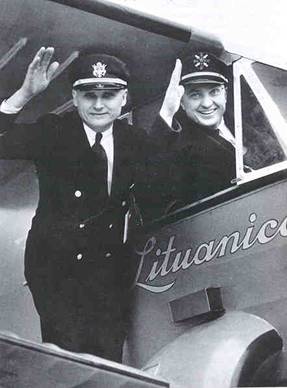
The American-Lithuanian pilots, Steponas Darius (1896-1933) and Stasys Girenas (1893-1933) attempted in the year 1933 to beat Charles Lindberg’s non-stop distance record across the Atlantic by flying from New York City to Kaunas, then the temporary capital of Lithuania.
Their plane, Lituanica, was an Bellanca CH-300 Pacemaker airplane. After successfully flying 6,411 km, it crashed, 650 km from its destination, Kaunas. Both pilots were killed.
Movie clip from the crash scene.
Steponas Darius was born at Rubiske, Lithuania in 1896 as Steponas Darasius. His father died while he was young; his mother remarried and the family moved to America in 1907. The family eventually settled in Bridgeport, a Lithuanian neighborhood in Chicago. While growing up, Steponas became quite the sportsman and played a variety of sports, including rugby, football, basketball, baseball, and boxing. In addition, he worked as an errand boy at an aviation store owned by famous aviation pioneer Wright brothers.
During World War I he shortened his surname to Darius, and joined the U.S. Army in 1917. He served valiantly in France and was awarded the “Purple Heart” and the “Great War for Civilization” medals. After returning to Chicago briefly after the War, Darius returned to his homeland Lithuania in 1920, which was fighting for its independence. He joined the Kaunas Military School and was promoted to the rank of lieutenant upon his graduation in 1921. He joined the training squadron of the Lithuaian Air Force in 1922, and participated in the 1923 liberation of Lithuania’s port city of Klaipeda. He served in the Lithuanian Air Force for 5 years, and was promoted to the ranks of flying officer, and flight lieutenant.
Having received a year’s leave from the Lithuanian army Darius left Lithuania in 1927 and returned to the United States to visit his friends and relatives there. On his journey home he witnessed the triumphant celebration for aviator Charles Lindbergh at Le Bourget Airport in Paris. Darius was inspired and determined that he would someday fly a plane from New York to Kaunas.
Upon his return to the United States, Darius earned various pilot’s licenses, including international and transport pilot. He began racing airplanes and also established an aviation company with an American pilot in Indiana. After some mechanical misfortunes, Darius left the firm in 1929 and returned to the Chicago area. He then began working for a Bellanca dealer at Palwaukee Airport north of Chicago. While there he became a pilot and instructor of Commercial aviation, and a master at flying all types of aircraft of his day.
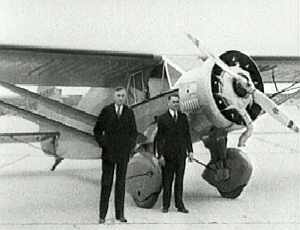
The pilots and their aircraft, Lituanica.
Steponas Darius teamed up with aviator Stasys Girenas in 1932, and the pair formed a flying partnership dedicated to a well-publicized trans-Atlantic flight. Girenas also had a similar background as his partner, having been born in Lithuania, educated in Chicago, and serving in the U.S. Army in World War I. The duo purchased a used Bellanca Pacemaker plane from the Chicago Daily News in 1932, dubbed it the “Lituanica” and modified it for their flight. Money was raised from numerous Lithuanian clubs and organizations to finance their operation.
The duo left Floyd Bennett Airport in New York City headed for Kaunas on July 15, 1933, and crashed over Soldin, Germany (115 km. north of Berlin) on July 17 after 35 hours in flight. It was strongly suspected that they were shot down by the Nazi’s after they strayed well into German airspace. A thorough investigation however, pointed to stormy, rainy weather and fog as the most likely deadly factor in their flight. Autopsies revealed no signs of any bullets on their bodies whatsoever. The bodies of the pilots and their plane were taken to Kaunas, and over 60,000 persons attended the funeral there. The duo have since been memorialized on numerous Lithuanian stamps, coins, medals, and decorations. Numerous monuments have been erected in their memory both in the United States and in Lithuania.
When Lithuania regained its independence in 1990, plans were made for the reestablishment of the national monetary system, the litas. A design competition was held for the various denominations. The 10 litù banknote was designed in 1991 by 28-year-old artist Giedrius Jonaitis (born 1963), a graduate of the Vilnius Art Academy, and a member of the Lithuanian Artists Association. The note’s design features the theme of Darius and Girìnas. The images of the flyers were based upon official 1933 press photographs of the duo. The back of the note features their plane flying over the waves of the Atlantic, with an outline of North America and Europe in the background. No boundaries of countries were drawn on the map portion, to avoid any controversies that existed as the result of the occupation of the capital city of Vilnius by Poland from 1920 to 1939, and subsequent Soviet-imposed boundaries following World War II.
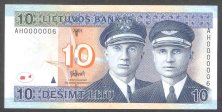
10 litu note showing face side
In 1934 Steponas Darius and Stasys Girėnas bodies were embalmed by professor Jurgis Zilinskas. In 1936 the Lithuanian government decided to build a mausoleum for them in Kaunas' old cemetery, that was destroyed after Soviet re-occupation. From then until the present day, the wreckage of Lituanica has been on display in the Vytautas the Great War Museum in Kaunas. At present the pilots' bodies rest in the Military Cemetery of Šančiai, Kaunas.
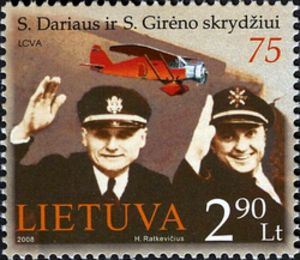
Pašto ženklas, 75th anniversary of
S. Darius and S. Girenas flight.
Chicago's Lithuanian community erected an Art Deco Monument commemorating the pilots in Chicago's Marquette Park in 1935 where it still stands to this day.
Feliksas Vaitkus flight was inspired by the flight and commemorated it with a flight of Lituanica II in 1935.
The flight is commemorated in a movie Skrydis per Atlantą (Flight over Atlantics - 1983). Kaunas's sports stadium, S.Darius and S.Girėnas Stadium where the Lithuanian national soccer team plays its home matches is also named in their honor. There is a tall stone monument near the stadium, the Lithuanian Academy of Sport and the Ąžuolynas Park dedicated to the pilots.
Sculptor Bronius Pundzius has made a relief of the pilots' faces on the Puntukas, then the largest known boulder in the territory of Lithuania in 1943.
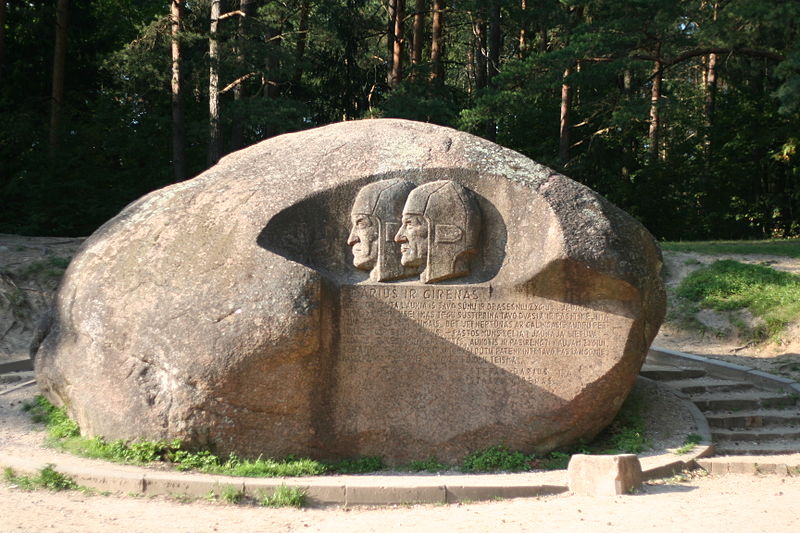
Relief at the Puntukas boulder, 1943.
- Bookmark :
- Digg
- del.icio.us
- Stumbleupon
- Redit it
VilNews e-magazine is published in Vilnius, Lithuania. Editor-in-Chief: Mr. Aage Myhre. Inquires to the editors: editor@VilNews.com.
Code of Ethics: See Section 2 – about VilNews. VilNews is not responsible for content on external links/web pages.
HOW TO ADVERTISE IN VILNEWS.
All content is copyrighted © 2011. UAB ‘VilNews’.

 Click on the buttons to open and read each of VilNews' 18 sub-sections
Click on the buttons to open and read each of VilNews' 18 sub-sections 



My dad flew with Stephen Darius. I believe it was around 1931. His Lithuanian parish in Kenosha Wi
was having a fund raiser. A friend of Darius' asked him to give plane rides to raise money.
My dad was selling tickets but was unable to afford one. At the end of the day, Darius said
to him "What about a plane ride for the young ticket seller?" He took my dad, just the two of
them, and made a quick loop around Kenosha Co. and landed. My dad was enthralled. Later
he joined the Army Air Corp, which became the Air Force, in 1941 and served as a bombadier navigator
in WWII.
[…] According to Mayor of Vilnius Arturas Zuokas, the new airline will be named .airLituanica after the plane of the two American-Lithuanian pilots, Steponas Darius and Stasys Girenas who in 1933 tried to beat Charles Lindberg’s non-stop distance record across the Atlantic by flying from New York City to Kaunas. Their Lituanica was an Bellanca CH-300 Pacemaker airplane. After successfully flying 6,411 km, it crashed, 650 km from its destination, Kaunas. Both pilots were killed. Ref: https://vilnews.com/?p=8867 […]
I visited the puntukas (described as a pebble in one guide book) memorial in 1974 and was greatly impressed.
Something I find very odd is that I have not found any reference to Darius and Girėnas in any of the histories of aviation I have looked at in Britain.
Could this be a consequence of Lietuva's many years of anonymity inside the Soviet Union? Similarly, in many maps and atlases produced before the 1990s, none of the Baltic States are shown.
Tese guys were the greatest.
[…] Read more… Category : Featured black / Front page […]